Welcome to my “1st of the month” internet marketing update for April!
On the 1st of every month, I write a blog post about some facet of internet marketing…something that can help you grow your online business. Nothing is ever sold on AidanBooth.com, it’s always 100% free content.
Today I’m discussing anchor text and link building…I hope you find it useful. THANKS for visiting!
Having trouble with the video? Watch it on YouTube here: http://youtu.be/DW0tU4v3UCs
NOTE: The information provided below is based on analysis of my own high-ranking websites and also on analysis of countless other successful websites. You can download a PDF version of this post here: Right Click & Select “Save As” To Download
Lets get started by talking about the types of anchor text you should be using…
I’m finding that using my URL and Website Name as the anchor text around 50% of the time is getting great results, in addition to this, a good number of random keywords (such as “click here”, “more information” etc) also help make link profiles look natural and you’ll get better rankings as a result.
The most important thing however is that you don’t overuse your target keywords…using your target keywords too often (more than 15%) will put your website in danger of being penalized by Google and pushed down the rankings.
The next thing you need to look at is where to “point” your links…in other words, which pages should your backlinks link to?
Even if you only have a couple of target pages, you still need to have links pointing to a wide range of different pages on your website. I find having 50% of my links pointing to my homepage works well, it provides a good base and your entire website will benefit from this.
The other 50% of the links should be split up between your target pages and other pages on your site.
Lets take an example…
- Assume your website has a homepage and 19 other pages (so 20 pages in total).
- Assume that 3 of the pages are “target pages” and the other 16 are “supporting pages” (pages that are not a strong focus from an SEO standpoint).
- Assume that you have 100 links coming into your site.
Based on what I’ve explained above, approximately 50 of the links should point to the homepage, around 30 should be split between your 3 target pages, and the other 20 split amongst the remaining 16 pages.
Now, you shouldn’t use this EXACT ratio every time…make sure you keep things random by varying the percentage of links that go to each page on your website (otherwise your link profile will start to look very repetitive to Google).
The next thing to consider is NoFollow and Follow links.
NoFollow links are links that don’t pass link juice to your website (although they do improve your rankings…) – you can read more about them here. Follow links are links that DO pass link juice to your website…traditionally these have been the types of links people have focused on as they’ve been seen as the only kind of links that help you move up the rankings (which is not true nowadays!).
You need both NoFollow and Follow links…lets take a look:
At least 10% of your links should be NoFollow links…ideally even a little more (up to 30%). If you don’t have any NoFollow links, it’s a sure sign to Google that you’re building links unnaturally and you’ll struggle with getting top rankings as a result.
For years people have said that NoFollow links don’t help you move up the rankings…studies have proven however, that they DO. In fact, I’ve seen websites that have been indexed and gotten to page 1 of Google with ONLY NoFollow links.
The next thing that you NEED to have is link relevancy. By that, I mean you need to have links coming to your website on pages or websites that are related to yours.
Here are the numbers you should aim for:
As far as relevancy is concerned, there are two types of relevancy:
1. Content Relevancy
A link with content relevancy is one that is surrounded by text which is related to your niche. An example would be link in an article directory such as EzineArticles.com. The EzineArticles.com website as a whole may not be specifically related to your niche, but the page where your links are may be very closely related, and this would give your links “content relevancy”.
Content relevant links are easy to get in places like Squidoo.com, HubPages.com, Article Directories, YouTube.com etc.
2. Site Relevancy
Links with “site relevancy” are links on websites which are related to your niche. So if you have a website about “iPhone Cases”, a link with site relevancy might come from another website about iPhones, or another website about “cases”. Links with site relevancy are the BEST links of all nowadays and are the links that’ll give you the biggest boost in rankings.
Building your own Feeder Sites and Niche Specific Mini-Blogs are easy ways to get site relevant links, another easy way to get these links is to make contact with other websites in your niche and ask them to give you a link (offering to pay helps!).
To finish up I want to give you a few more tips about other SEO “Best Practices”…
Link Diversity
Link Diversity is having links coming to your website from a range of different types of websites. That means you need to make sure that you’re getting links from Videos, Blogs, Articles, Sidebars, Web 2.0 properties, Press Releases, Facebook Pages, Google+ profiles, etc etc etc…as many DIFFERENT types of websites as possible.
Link diversity is a CRITICAL part of the puzzle and without it you’ll struggle to get rankings.
C-Class Variation
You need to make sure that your backlinks are coming from different “C-Class IP Addresses”. This is “tech-talk” for ensuring that your links aren’t all coming from websites hosted on the same servers. You only really need to watch out for this if you’re getting all your links from blog networks or from websites which you own and host on one server.
Continued Link Growth
Part of a natural looking link profile is natural looking link growth. It’s important that you consistently build links over time…not necessarily hundreds of links per month every single month, but at least a few new links will help keep your link growth natural.
The amount of link growth you need will depend on your niche and the history of your link growth. If your website has always received hundreds of new links per month, then ideally you should try to maintain this…dropping down to just a few new links per month could raise a “red flag” with Google. If on the other hand you’ve never had an overly aggressive link building plan, then just a few new links per month will look natural.
Final Thoughts
To sum up, your link building needs to look natural.
That means lots of variation…variation in EVERYTHING (anchor text, types of sites, pages the links point to, etc etc etc).
If any part of your link profile looks unnatural, then your website runs the risk of coming under Googles microscope and losing rankings.
Keep in mind that the recommendations I’ve given here are a general guide. Every niche is a little bit different and in-depth analysis of the top websites in your niche is the only sure-fire way to know exactly what Google expects for your niche.
If you’ve found this useful, click the Like button!
If you’ve got a question or comment, leave it below – I read them all, and they all get approved!
[loveclaw_buttons]



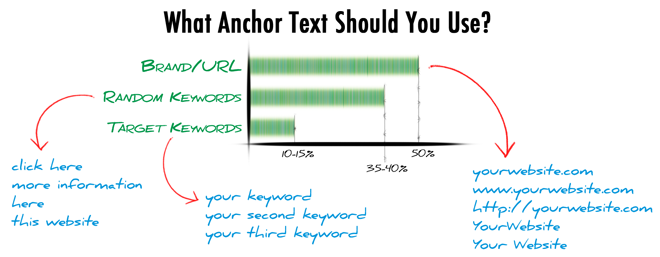
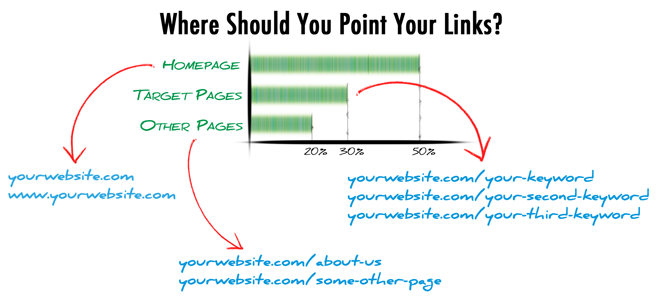
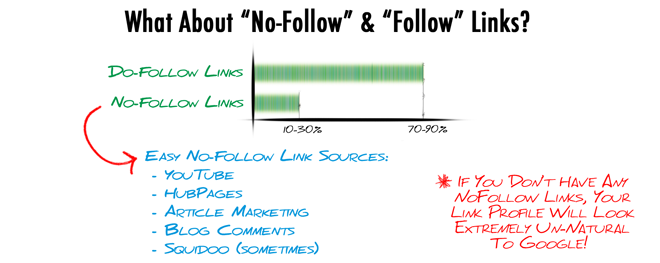
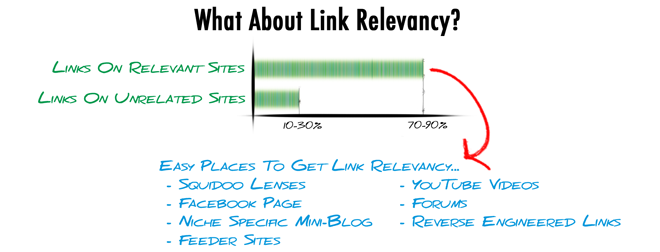
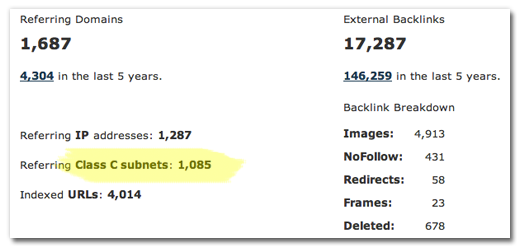



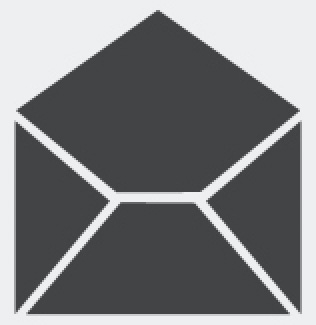

Hey Aidan,
Good advice. A natural mix of links is the way to go. I used to have almost all my links coming from a link network. This worked a year or so ago, but my sites bombed after the Google updates.
Since improving my onpage engagement methods (as per your Page One Evolution teachings) and mixing up my inbound links/anchor text, many (not all) of my sites have crept back up the rankings.
Hi Peter, I’m really glad to hear your websites have started to bounce back Thanks for commenting!
Thanks for commenting!
Great article, but I have a question. From last couple of months I have been trying to remove and edit the links of my own website, but it has been constantly dropping in alexa ranking. Should I start a new website on this same niche? Or should I still try to change its anchor text. Here is my website http://exrecoverysystemreviews.info.
Hi Alan,
I personally wouldn’t use a “.info” website…I recommend you start again (great niche) but use a .com
As for “fixing” broken websites, the way I think about it is the following:
If it’s going to take more than 3 months to fix, then you should start a new site.
Hope this helps!
Thanks Aidan,
It has PR 3 in February 2012, but now it has PR 1. I bought .info domain because it was cheaper than a .com domain. I was just experimenting with niche site at that time. Anyway, does .info consider as too spammy domain by Google?
One more question, how much we should depend on article directories for link building? Which article directory is best in your eyes these days.
Hi Alan,
“.info” domains are definitely not what you should be using for Authority Sites…they’re definitely not taken as seriously by Google.
As for article directories, they form a small part of my link plan, I definitely don’t rely on them much but they are a useful resource to leverage (even nowadays, they still help!).
Clear and insightful Aidan, thanks
Hi Aidan,
Great information, I always check out your posts and information in your emails. Your information is always top notch and very helpful. Page One Evolution is a fantastic course and has been one of the best courses I have purchased. Thanks for this valuable post.
Conley
Thanks Conley! Glad you’ve found it useful!
Hi Aidan,
Finally, just in time to implement on a new website. Thanks
You have more information in this post than many so called gurus would have in an entire product. This coming from a sucker that purchased the several.
You speak, I listen!
GREAT!
Aidan,
Solid article on the backilinking process. I can never get enough of your insights. Great job on the the connection between the video and written text. Its was very effective to hear you narrate and then follow down the page!
Glad you enjoyed it Dan, and thanks for the feedback about the video. I haven’t used them much on this site in the past, but perhaps I’ll use them more regularly moving forward
Great stuff here Aidan … I’m going to listen to this video several more times as you have loaded it with a lot of useful info.
Awesome, glad it helps Robert!
hi aidan…
is your anchor text guidelines for tier 1 only?
Hi Duma,
Yes, it’s based on the links that are coming in to your main website. The same kind of thing should be done for tier 2 sites as well though.
Another ridiculously great article Aidan. You make the crappiest stuff seem interesting and more importantly, understandable. And yeah, link building is crap! But I know, necessary.
So much information packed into these. Please keep them coming
Mike
Haha – thanks Mike!
You don’t have me fooled Aidan, I know perfectly well to do the exact opposite of everything you say today, for best results.
Hi Erinn, haha, let me know how that works out for you
Great information and sharing the ahrefs site. I just ran reports on some of my sites and I can easily see where my gaps are and what I need to do to improve. Thanks for sharing!
Hi, I have an interesting issue. Originally pre panda Penguin it was recommended to keep ownership open in the light of day. Now with the move to build private blog networks with private registration I am wondering if I change from public to private and move these domains to other accounts on seperate class C IP’s will Google be able to find them from past registration. Up to this moment none of these domains have been promoted, mostly populated with a basic WP just to keep alive.
ty Keith
Hi Keith,
This is a big grey area…Google is VERY smart and can work most things out…but if you REALLY want to hide a site (like a feeder site), then yes, it is better to make get Private Registration.
Another option is to open an entirely new GoDaddy (or some other) account, and use that for your Feeder sites etc.
The hosting should definitely be separated…keep your main websites in one account, and have different hosting solutions for your other sites.
Thanks for visiting AidanBooth.com!
Great information, but I have a couple of “noob” questions:
1) You mention offering money for links on related sites. Is this “google-approved”? I thought paid links were being penalized.
2) What’s the definition of “target pages”? Like pages with affiliate links or other “money” actions on them?
Thanks!
Hi Mike, thanks for commenting.
Regarding your questions:
1) You mention offering money for links on related sites. Is this “google-approved”? I thought paid links were being penalized.
Paid links are frowned upon by Google…but if you’re getting a link on a related site, is it really such a bad thing? What if I were to link to an internet marketing site from this website…if it was a good quality site, how would Google ever know if it was a paid link or not?
You’re thinking along the right lines with your question, but also keep in mind that most successful websites do use some form of “paid links”…often it’s just called advertising (paying for banners on other peoples sites)
2) What’s the definition of “target pages”? Like pages with affiliate links or other “money” actions on them?
Good question “Target Pages” are the pages you MOST want to rank in Google. Typically these are the pages that are most likely to make you money.
“Target Pages” are the pages you MOST want to rank in Google. Typically these are the pages that are most likely to make you money.
Hi Aidan,
This ain’t no April Fool’s joke! Another amazing free post and video chock full of useful information for link building in 2013.
Keep this up and no one will buy your courses!
Aidan,
Thanks again for a great article and accompanying video. The info about C class server variation and how to find it was excellent.
Also, thanks for sharing the free and paid options for checking our sites and competitors’ sites.
Thanks Aidan. This info in pdf format for future reference would be helpful.
Hi Marke, I actually have that prepared for you, I’ll upload it later
Never post anything like this at 1.april again
One question about relevancy do I have. If i get a guest post on a foreign site within my niche, will it still be good SEO or must it be in the same language? (English sites is foreign for me)
I recommend getting links on sites in the same language as yours – thats really the best idea (and it makes the most sense). I’m not sure that a link on a website in another language will hurt you though, I’ve never actually tested that…
Holy cow Aidan. When I got your email this morning I was expecting a brief video on this at best.
However, was plesantly suprised to see all this detailed info. Knowing this will certainly come in handy when building our sites. Thanks for sharing.
Now, just gotta spend some time to digest this
Glad it helps Shaun!!
Practical and immediately usable content yet again Aidan. Thank you.
I always figured that each page on a website was based on a “target keyword or two” so it was interesting to read your comment about having “other” or supporting pages – as opposed to target pages – defined as (pages that are not a strong focus from an SEO standpoint).
Would you mind clarifying that point more please.
Many thanks in advance
JR
Hi JR,
I normally have two types of pages on my websites…target pages, and other “supporting” pages that exist purely to add more content to my sites and make it more valuable.
Hi Aidan,
Can you clarify one thing here. Say I have 100 inbound links, 50 of which have brand/url anchor text. Should all these go to the homepage or split 50% homepage, 30% target page and 20% other pages say?
Hi David,
You always need to split the links up and point them to different places, regardless of whether the anchor text is target keywords, brand/URL or random keywords…the URL links should go to internal pages as well.
Adian,
Excellent article on what anchor text we should be using to get rankings.
What method do you use to track and ensure your websites backlinks comply with the diversity of anchor text as discussed in this article?
Hi Larry, I don’t really track it all that much, I just take it into account when I’m doing the link building, and remember to work on the variation. If I was to track it thoroughly though, I’d use an excel spreadsheet.
I believe that Squidoo links are now all no-follow links. Has this affected the manner in which you use squidoo for backlinking.
Hi Stuart, yes, this is true (you can read the release of this info here: http://hq.squidoo.com/squid-news/changing-link-status-on-squidoo/). All this means is that we need to look at other places to get high quality Follow links, NoFollow Squidoo links will still help though.
Blinding, quality information as always from you, Aidan.
I’d appreciate your input on this little SEO/anchor text teaser that I can’t quite get my head around:
Do you think having a NO-follow anchor text link coming from a PR4 ‘site relevant’ page carries the same weight it would if it were a DO-follow anchor text link.
I have a competitor whose PR 0 internal pages outrank my PR 2 internal pages for my main keywords and appears to do it by merely paying for just ONE NO-follow anchor text link on a PR 4 site relevant PR 4 page. No other links, as far as i can see, point to their ‘higher rankings than mine’ pages.
It really baffles me why! Any ideas?
Hi Chris,
A DoFollow link will always push you up MORE than a NoFollow link, but in saying that, you still NEED NoFollow links…
As for your competitor, he is probably leveraging he power of his own domain name…perhaps Google trusts his domain a lot, and as a result he can get higher rankings with fewer links (he may also have a lot of internal links).
Hi Aidan
Great to see the principles laid out in such a user-friendly and visual fashion. Great job.
I have been full-time marketing online for 13 years now, and true to say, it is quality over quantity now. I have had new sites overtake big mature sites in page rank and authority in just a few months, so I know your advice is solid. Thanks for sharing.
G’day Aidan
Very intriguing stuff once again. And a very interesting comment from Christopher Evans, too.
I’m a tad curious though. My “authority” site has a number of products in a store. Several of these products also have their own sites (sales page), to which I’ve linked from the authority site but not linking back from these landing pages. Is there any merit in placing a link somewhere in the footer on these landing pages back to my authority site?
Thanks again for your generosity.
Hi Des,
Placing a link to your authority site on the sales page could help your authority sites rankings, and I don’t think it’d do much harm to the sales page. A link on any related site will only ever help you
Hi Aidan,
As usual, great stuff that makes good sense. Thanks!!
What is your advice on using a “recommends” directory that contains subdirectories to hold all of your affiliate links? Like mysite.com/recommends/ProductA etc, and the subdirectory contains a index.php file pointing to the affiliate product? Of course the URLs would be nofollow and the robots.txt file would contain the “disallow for the /recommends directory.
Do you think Google would frown on this?
Thanks!!
Zeek
I think thats fine Zeek. I personally use a plugin (PrettyLink) which does something similar.
Hi Aidan,
This was extraordinarily good. I like the extra care that went into the graphical elements. This made reviewing and understanding the concepts very easy.
Sometime maybe you can talk about the plugins, software or other techniques you use to:
• Create the PDF to download.
• Create the quick graphical elements
• etc.
And, special thanks for creating the Page One Evolution product. I have considerable experience online and expected to skim over much of the material. But, that has not been the case. Very meaty and very valuable all the way through.
Warm regards,
Bill
Hi Aidan, Thank you for laying this out in a very digestible fashion. The first thing I did was copy your article and paste it into my file with your Page One Evolution wso. I’ve been applying those principals over the last few weeks and had some great results. This seems like a logical extension and great common (not so commonly known) sense.
I think the biggest shift for me is having diverse anchor text. It’s so easy to fall into the trap of making everything so ‘seo’d’ that it can burn us. A paradoxical knife that google obviously enjoys twisting.
Thanks again for all this great content and insight. You are very appreciated
Kind regards
Kev Webster
Hi Kev, thanks for the comment!
Right on dude, AWESOME stuff. I found your homepage-to-innerpage ratio particularly useful for my business right now. You mention “Other Pages” in that section, but do you even include those on authority affiliate sites? Are those pages important for your SEO strategy and general site building strategy?
Side note about no-follow links: I LOVE them! Can’t get enough of them! Ever since I started using them after page 1 evolution I realized you can get great power links in tons of cool places if your not concerned about follow vs nofollow. And its been working for me
Hi Josh, good to hear you’re seeing results with the Power Links and NoFollow links!!
With regards to linking to other random pages on your site, yes, it’s definitely the best thing to be doing, it makes you link profile look more natural.
Hi Aidan,
Great stuff here on your site. Glad I found it!
I wanted to know about what you think about putting multiple sites under one Google Analytics account? Do you think it is safe or do you think I would be better off in separating all of my sites just in case goog throws a tantrum and my sites aren’t connected?
Hi Jeff, I think it’s fine to do that
Hi Aidan,
I’ve looked at this about 5 times now (at my age things take a little while to sink in) Anyway, anyone not practising this strategy or something similar are going to miss out big time in the future.
Very helpful!
Aidan,
I am part of your ongoing training and listened to the video where you recommended coming here and checking this out. Unfortunately, I have no idea what you are talking about. I have noticed on the new website you are building for our training that there are all these little pop-ups that appear on certain words. The pop-ups have no relative meaning to your website. Are these what you are talking about for “links.” I find these pop-ups very annoying. When I am searching the internet for information on any subject, if I encounter one of these, I immediately leave that website. I don’t see the value of these pop-ups if everyone is like me and leaves quickly. Maybe this is not what you mean when you are discussing links above.
Hi Kathy, thanks for your comment.
The little “pop-ups” your seeing are because of something you have installed on your computer…they’re definitely NOT built into my website by me…the pop-ups are annoying and I think that they must be appearing because of some plugin or something that you have on your computer, I’m sure if you check my site on another computer/phone/tablet you won’t see them…
Thank you much, Aidan. I checked the name on the pop-ups and went into the computer programs and uninstalled that name. It worked.
Hi Aidan
How come your website shows a really bad backlink profile and no rankings in google?
Did you get penalized?
Hi Ani, thanks for the comment…
I haven’t done ANY link building to this website and I’m not trying to get rankings for any keyword at all…AidanBooth.com is all about sharing free useful information with other internet marketers, which is what I do on the 1st of each and every month. I hope you find it useful.